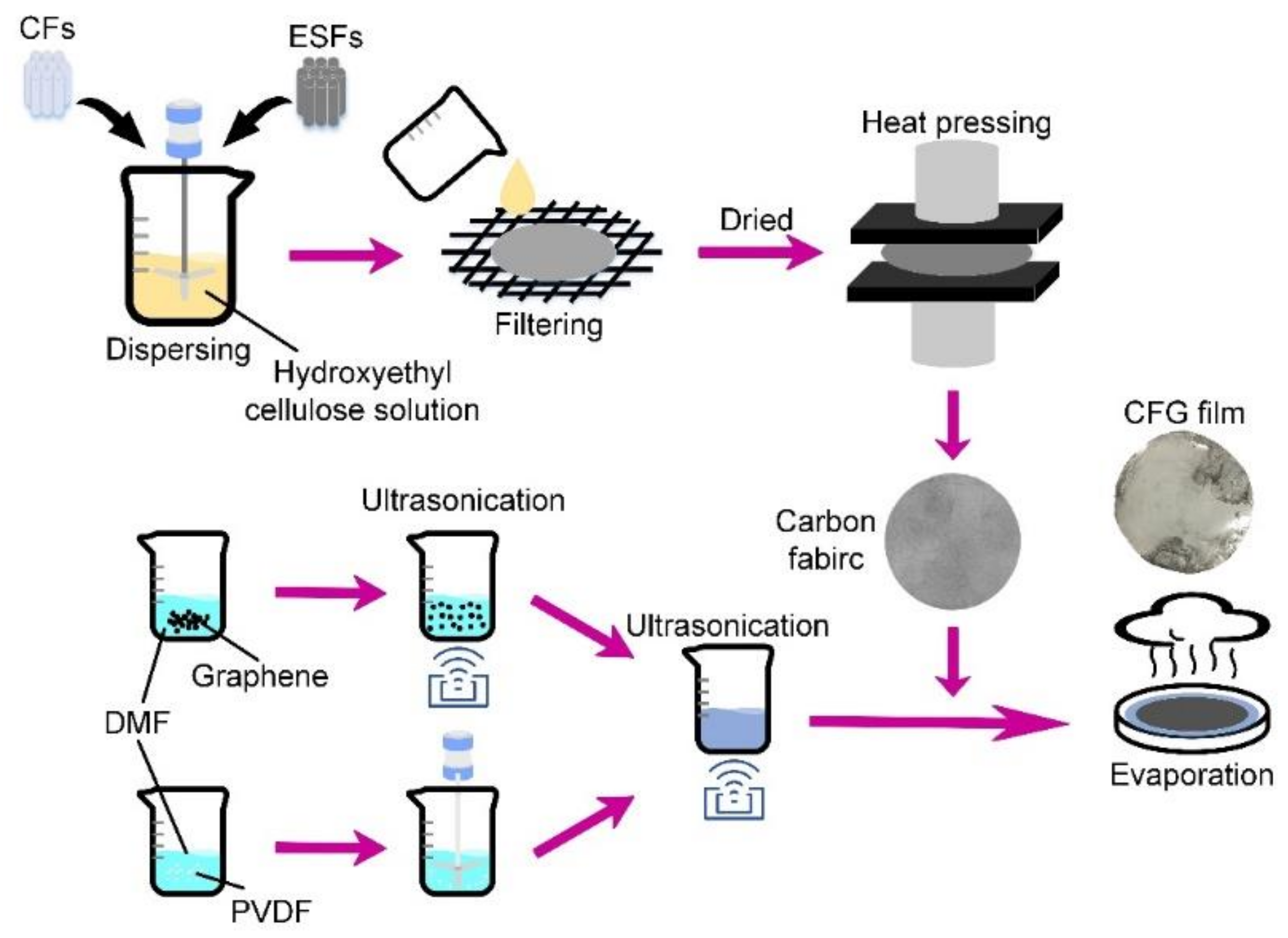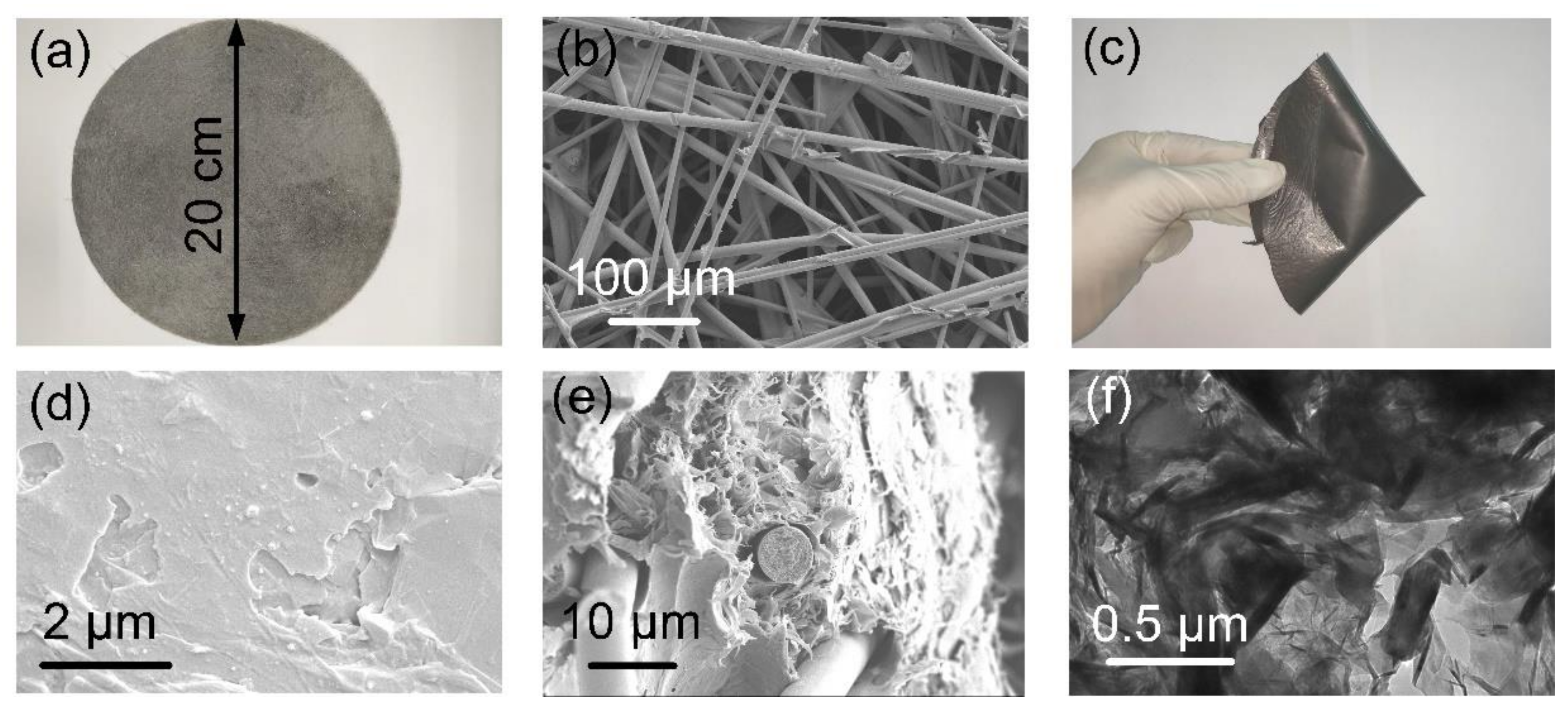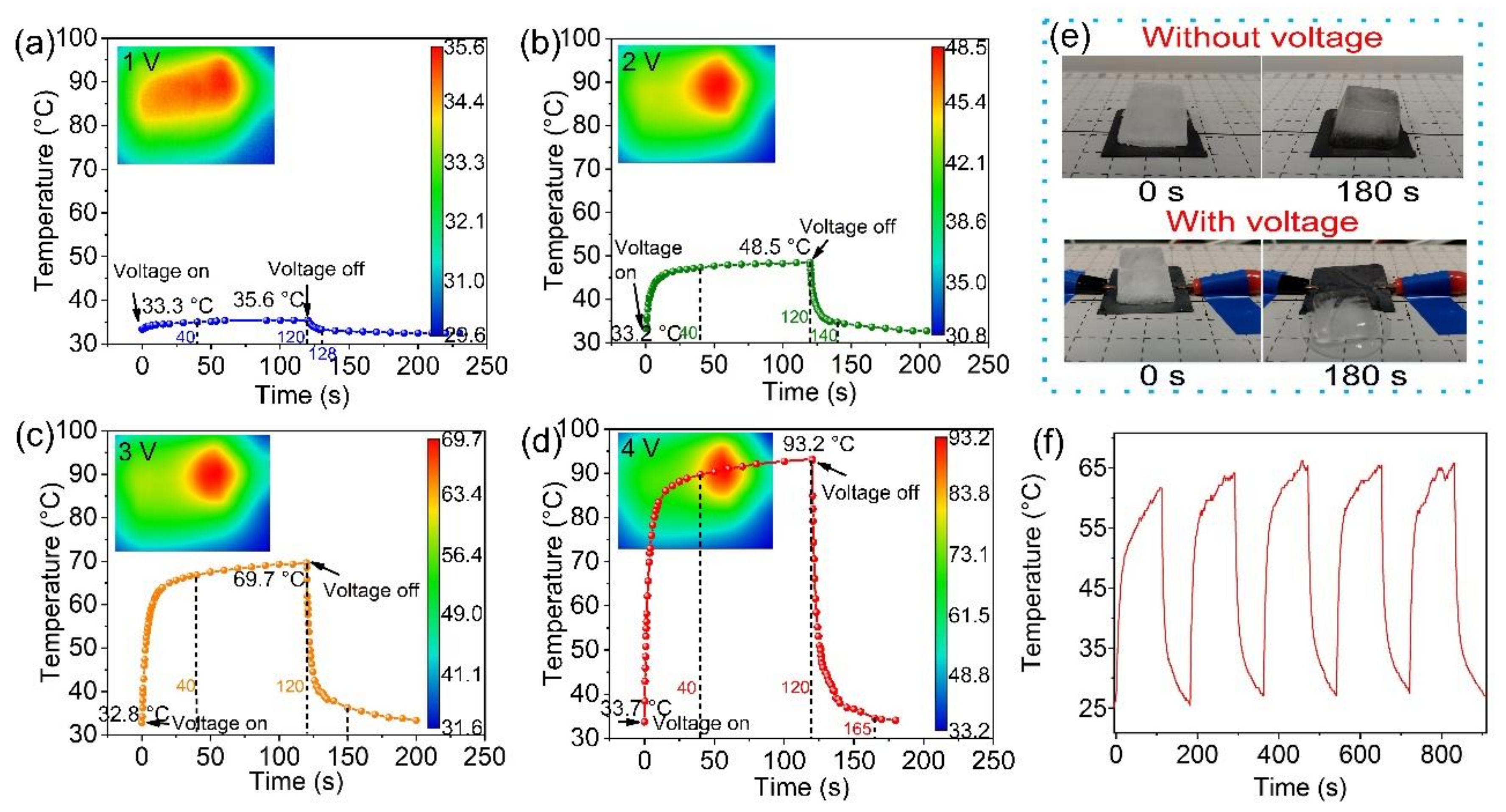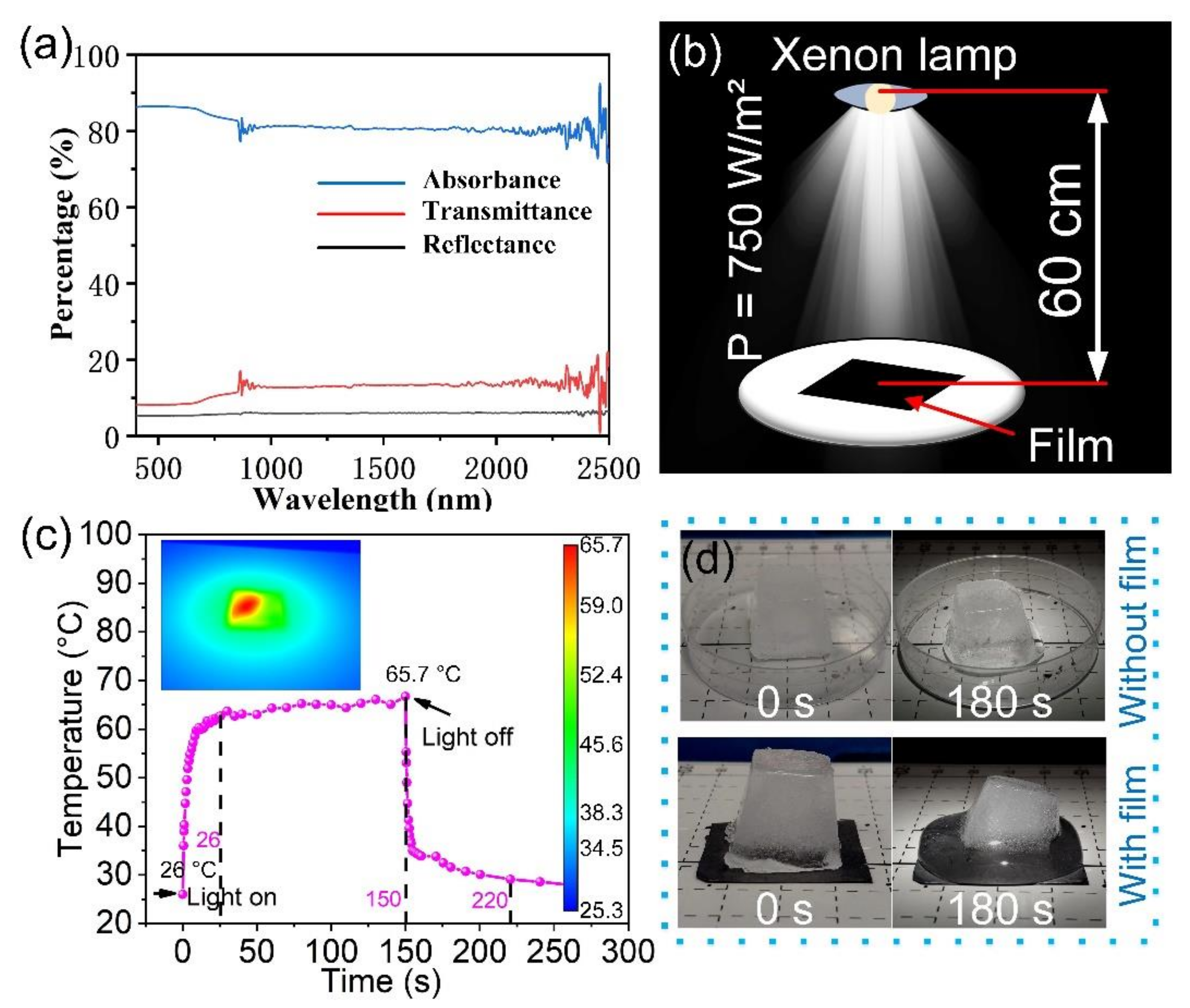A Carbon Composite Film with Three-Dimensional Reticular Structure for Electromagnetic Interference Shielding and Electro-Photo-Thermal Conversion
Abstract
1. Introduction
2. Materials and Methods
- (i)
- To prepare a carbon fabric, first, the pre-prepared ESFs and chopped CFs, both with a length of 6 mm, were mixed and dispersed in hydroxyethyl cellulose solution. Then, the mixed solution was stirred for 4 min at 700 rpm and stood for 5 min. After that, the mixed stable solution was filtered via stainless steel mesh (#80) to obtain a wet preformed carbon fabric, which was next dried at 80 °C for 30 min. Afterwards, the preformed carbon fabric was heat-pressed to form a flexible and robust carbon fabric [16] using a curing press at 170 °C and 6 MPa.
- (ii)
- To prepare a homogenized solution of graphene and PVDF, first of all, graphene nanoplatelets and PVDF powders, respectively, were weighed and added in DMF solvent. The PVDF/DMF solution was treated by ultrasonication at 60 °C for 6 h to get evenly dispersed, and the graphene/DMF solution was mechanically stirred at 60 °C for 2 h. Then, they are mixed and treated in the same way as the dispersion of graphene/DMF solution.
- (iii)
- To prepare a CFG film, in the beginning, the pre-dried carbon fabric was immersed into the homogenized solution of graphene and PVDF. Later, the resulting mixture was transferred to a Petri dish with a non-stick polyimide film on the bottom. Subsequently, the Petri dish containing the mixture was put in an oven at 80 °C for about 18 h to remove all DMF. During evaporation, the mixture should be transferred to a new container in time to avoid the difference in moisture between upper and lower layers, which may cause the upper and lower layers to contract and expand at different degrees, resulting in the final film wrinkling. Finally, an ultra-thin CFG film can be taken off from the polyimide film [17].
3. Results and Discussion
3.1. Morphological Observation
3.2. EMI Shielding Performance
3.3. Electro-Photo-Thermal Effect
4. Conclusions
Author Contributions
Funding
Institutional Review Board Statement
Informed Consent Statement
Data Availability Statement
Conflicts of Interest
References
- Sharma, V.; Srinivasan, K.; Chao, H.-C.; Hua, K.-L.; Cheng, W.-H. Intelligent deployment of UAVs in 5G heterogeneous communication environment for improved coverage. J. Netw. Comput. Appl. 2017, 85, 94–105. [Google Scholar] [CrossRef]
- Shahzad, F.; Alhabeb, M.; Hatter, C.B.; Anasori, B.; Man Hong, S.; Koo, C.M.; Gogotsi, Y. Electromagnetic interference shielding with 2D transition metal carbides (MXenes). Science 2016, 353, 1137–1140. [Google Scholar] [CrossRef]
- Liu, J.; Lin, S.; Huang, K.; Jia, C.; Wang, Q.; Li, Z.; Song, J.; Liu, Z.; Wang, H.; Lei, M.; et al. A large-area AgNW-modified textile with high-performance electromagnetic interference shielding. NPJ Flex. Electron. 2020, 4, 1–7. [Google Scholar] [CrossRef]
- Tran, V.V.; Nguyen, D.D.; Nguyen, A.T.; Hofmann, M.; Hsieh, Y.P.; Kan, H.C.; Hsu, C.C. Electromagnetic Interference Shielding by Transparent Graphene/Nickel Mesh Films. ACS Appl. Nano Mater. 2020, 3, 7474–7481. [Google Scholar] [CrossRef]
- Yang, Y.; Chen, S.; Li, W.; Li, P.; Ma, J.; Li, B.; Zhao, X.; Ju, Z.; Chang, H.; Xiao, L.; et al. Reduced Graphene Oxide Conformally Wrapped Silver Nanowire Networks for Flexible Transparent Heating and Electromagnetic Interference Shielding. ACS Nano 2020, 14, 8754–8765. [Google Scholar] [CrossRef] [PubMed]
- Yu, Z.; Dai, T.; Yuan, S.; Zou, H.; Liu, P. Electromagnetic Interference Shielding Performance of Anisotropic Polyimide/Graphene Composite Aerogels. ACS Appl. Mater. Interfaces 2020, 12, 30990–31001. [Google Scholar] [CrossRef] [PubMed]
- Ma, L.; Lu, Z.; Tan, J.; Liu, J.; Ding, X.; Black, N.; Li, T.; Gallop, J.; Hao, L. Transparent Conducting graphene hybrid films to improve electromagnetic interference (EMI) shielding performance of graphene. ACS Appl. Mater. Interfaces 2017, 9, 34221–34229. [Google Scholar] [CrossRef] [PubMed]
- Rani, P.; Ahamed, M.B.; Deshmukh, K. Dielectric and electromagnetic interference shielding properties of carbon black nanoparticles reinforced PVA/PEG blend nanocomposite films. Mater. Res. Express 2020, 7, 1–12. [Google Scholar] [CrossRef]
- Truman, L.; Whitwam, E.; Nelson-Cheeseman, B.B.; Koerner, L.J. Conductive 3D printing: Resistivity dependence upon infill pattern and application to EMI shielding. J. Mater. Sci. Mater. Electron. 2020, 31, 14108–14117. [Google Scholar] [CrossRef]
- Ribeiro, B.; Corredor, J.A.R.; de Paula Santos, L.F.; Gomes, N.A.S.; Rezende, M.C. Electrical conductivity and electromagnetic shielding performance of glass fiber-reinforced epoxy composites with multiwalled carbon nanotube buckypaper interlayer. J. Mater. Sci. Mater. Electron. 2021, 32, 1962–1976. [Google Scholar] [CrossRef]
- Verma, R.; Rathod, M.J.; Goyal, R.K. High electromagnetic interference shielding of poly(ether-sulfone)/multi-walled carbon nanotube nanocomposites fabricated by an eco-friendly route. Nanotechnology 2020, 31, 1–14. [Google Scholar] [CrossRef]
- Castañeda-Uribe, O.A.; Avila, A. Enhancing Electromagnetic Interference Shielding Effectiveness of Polymer Nanocomposites by Modifying Subsurface Carbon Nanotube Distribution. Adv. Eng. Mater. 2021, 23, 1–8. [Google Scholar] [CrossRef]
- Shen, Z.; Feng, J. Preparation of Thermally Conductive Polymer Composites with Good Electromagnetic Interference Shielding Efficiency Based on Natural Wood-Derived Carbon Scaffolds. ACS Sustain. Chem. Eng. 2019, 7, 6259–6266. [Google Scholar] [CrossRef]
- Gao, W.; Zhao, N.; Yu, T.; Xi, J.; Mao, A.; Yuan, M.; Bai, H.; Gao, C. High-efficiency electromagnetic interference shielding realized in nacre-mimetic graphene/polymer composite with extremely low graphene loading. Carbon N. Y. 2020, 157, 570–577. [Google Scholar] [CrossRef]
- Luo, J.; Huo, L.; Wang, L.; Huang, X.; Li, J.; Guo, Z.; Gao, Q.; Hu, M.; Xue, H.; Gao, J. Superhydrophobic and multi-responsive fabric composite with excellent electro-photo-thermal effect and electromagnetic interference shielding performance. Chem. Eng. J. 2020, 391, 123537. [Google Scholar] [CrossRef]
- Lu, L.; Xing, D.; Teh, K.S.; Liu, H.; Xie, Y.; Liu, X.; Tang, Y. Structural effects in a composite nonwoven fabric on EMI shielding. Mater. Des. 2017, 120, 354–362. [Google Scholar] [CrossRef]
- Mei, X.; Lu, L.; Xie, Y.; Wang, W.; Tang, Y.; Teh, K.S. An ultra-thin carbon-fabric/graphene/poly(vinylidene fluoride) film for enhanced electromagnetic interference shielding. Nanoscale 2019, 11, 13587–13599. [Google Scholar] [CrossRef]
- Wei, Q.; Pei, S.; Qian, X.; Liu, H.; Liu, Z.; Zhang, W.; Zhou, T.; Zhang, Z.; Zhang, X.; Cheng, H.M.; et al. Superhigh Electromagnetic Interference Shielding of Ultrathin Aligned Pristine Graphene Nanosheets Film. Adv. Mater. 2020, 32, 1–9. [Google Scholar] [CrossRef]
- Xing, D.; Lu, L.; Teh, K.S.; Wan, Z.; Xie, Y.; Tang, Y. Highly flexible and ultra-thin Ni-plated carbon-fabric/polycarbonate film for enhanced electromagnetic interference shielding. Carbon N. Y. 2018, 132, 32–41. [Google Scholar] [CrossRef]
- Mei, X.; Lu, L.; Xie, Y.; Yu, Y.-X.; Tang, Y.; Teh, K.S. Preparation of Flexible Carbon Fiber Fabrics with Adjustable Surface Wettability for High-Efficiency Electromagnetic Interference Shielding. ACS Appl. Mater. Interfaces 2020, 12, 49030–49041. [Google Scholar] [CrossRef]
- Dias, E.J.C.; Yu, R.; García de Abajo, F.J. Thermal manipulation of plasmons in atomically thin films. Light Sci. Appl. 2020, 9. [Google Scholar] [CrossRef] [PubMed]
- Tian, S.; He, P.; Chen, L.; Wang, H.; Ding, G.; Xie, X. Electrochemical Fabrication of High Quality Graphene in Mixed Electrolyte for Ultrafast Electrothermal Heater. Chem. Mater. 2017, 29, 6214–6219. [Google Scholar] [CrossRef]
- Hao, Y.; Tian, M.; Zhao, H.; Qu, L.; Zhu, S.; Zhang, X.; Chen, S.; Wang, K.; Ran, J. High Efficiency Electrothermal Graphene/Tourmaline Composite Fabric Joule Heater with Durable Abrasion Resistance via a Spray Coating Route. Ind. Eng. Chem. Res. 2018, 57, 13437–13448. [Google Scholar] [CrossRef]
- Zheng, Z.; Jin, J.; Xu, G.K.; Zou, J.; Wais, U.; Beckett, A.; Heil, T.; Higgins, S.; Guan, L.; Wang, Y.; et al. Highly Stable and Conductive Microcapsules for Enhancement of Joule Heating Performance. ACS Nano 2016, 10, 4695–4703. [Google Scholar] [CrossRef]
- Hu, P.; Lyu, J.; Fu, C.; Gong, W.B.; Liao, J.; Lu, W.; Chen, Y.; Zhang, X. Multifunctional Aramid Nanofiber/Carbon Nanotube Hybrid Aerogel Films. ACS Nano 2020, 14, 688–697. [Google Scholar] [CrossRef]
- Zhang, X.; Wang, X.; Lei, Z.; Wang, L.; Tian, M.; Zhu, S.; Xiao, H.; Tang, X.; Qu, L. Flexible MXene-Decorated Fabric with Interwoven Conductive Networks for Integrated Joule Heating, Electromagnetic Interference Shielding, and Strain Sensing Performances. ACS Appl. Mater. Interfaces 2020, 12, 14459–14467. [Google Scholar] [CrossRef]
- Wang, W.; Cai, Y.; Du, M.; Hou, X.; Liu, J.; Ke, H.; Wei, Q. Ultralight and Flexible Carbon Foam-Based Phase Change Composites with High Latent-Heat Capacity and Photothermal Conversion Capability. ACS Appl. Mater. Interfaces 2019, 11, 31997–32007. [Google Scholar] [CrossRef]
- Jin, Q.; Liu, J.; Zhu, W.; Dong, Z.; Liu, Z.; Cheng, L. Albumin-Assisted Synthesis of Ultrasmall FeS2 Nanodots for Imaging-Guided Photothermal Enhanced Photodynamic Therapy. ACS Appl. Mater. Interfaces 2018, 10, 332–340. [Google Scholar] [CrossRef]
- Loeb, S.; Li, C.; Kim, J.H. Solar Photothermal Disinfection using Broadband-Light Absorbing Gold Nanoparticles and Carbon Black. Environ. Sci. Technol. 2018, 52, 205–213. [Google Scholar] [CrossRef]
- Zhang, R.; Song, C.; Kou, M.; Yin, P.; Jin, X.; Wang, L.; Deng, Y.; Wang, B.; Xia, D.; Wong, P.K.; et al. Sterilization of Escherichia coli by Photothermal Synergy of WO3−x/C Nanosheet under Infrared Light Irradiation. Environ. Sci. Technol. 2020, 54, 3691–3701. [Google Scholar] [CrossRef]
- Park, T.; Na, J.; Kim, B.; Kim, Y.; Shin, H.; Kim, E. Photothermally Activated Pyroelectric Polymer Films for Harvesting of Solar Heat with a Hybrid Energy Cell Structure. ACS Nano 2015, 9, 11830–11839. [Google Scholar] [CrossRef]





| Materials | Mass Fraction | Notes | ||
|---|---|---|---|---|
| CFG film | Carbon fabric | 8.6 wt%, 40 gsm | CFs 40 wt% | Polyacrylonitrile (PAN)-based CFs |
| ESFs 60 wt% | Composed of PE sheath (melting region: 130–150 °C) and PP core (melting region: 180–200 °C) | |||
| PVDF | 51.4 wt% | Forming a porous lamellar matrix | ||
| Graphene | 40 wt% | |||
| Auxiliary materials | Hydroxyethyl cellulose solution | 1.2 wt% | A dispersion agent for CFs and ESFs | |
| N, N-dimethylformamide (DMF) | Moderate | A solvent for PVDF powder and graphene | ||
| Materials | ΔT (°C) | U (V) | t (s) | Sete (°C V−1 s−1) | Ref. |
|---|---|---|---|---|---|
| Graphene ink on A4-size paper or polyester | 50.2 | 10 | 30 | 0.1673 | [22] |
| Graphene/tourmaline composite fabric | 63.8 | 10 | 40 | 0.1595 | [23] |
| C22@GO–CNT microcapsules | 57.5 | 6 | 300 | 0.03194 | [24] |
| ANFs/CNTs hybrid aerogel films | 113.5 | 10 | 40 | 0.2837 | [25] |
| MXene-decorated cotton fabrics | 65 | 4 | 50 | 0.3250 | [26] |
| CFG film | 67.2 | 4 | 40 | 0.4200 | This work |
| Materials | ΔT (°C) | E (W m−2) | t (s) | Spte (°C W−1 m2 s−1) | Ref. |
|---|---|---|---|---|---|
| Carbon foam-based phase change composites | 26.3 | 870 | 100 | 3.02 × 10−4 | [27] |
| FeS2 nanodots | 29 | 800 | 300 | 1.21 × 10−4 | [28] |
| Carbon black | 18.5 | 1000 | 1800 | 1.02 × 10−5 | [29] |
| WO3−x/C nanosheet | 154 | 2000 | 200 | 3.85 × 10−4 | [30] |
| Pyroelectric polymer films | 16.7 | 1640 | 20 | 5.09 × 10−4 | [31] |
| CFG film | 39.7 | 750 | 26 | 2.04 × 10−3 | This work |
Publisher’s Note: MDPI stays neutral with regard to jurisdictional claims in published maps and institutional affiliations. |
© 2021 by the authors. Licensee MDPI, Basel, Switzerland. This article is an open access article distributed under the terms and conditions of the Creative Commons Attribution (CC BY) license (https://creativecommons.org/licenses/by/4.0/).
Share and Cite
Lin, N.; Chen, H.; Mei, X.; Chai, S.; Lu, L. A Carbon Composite Film with Three-Dimensional Reticular Structure for Electromagnetic Interference Shielding and Electro-Photo-Thermal Conversion. Materials 2021, 14, 2423. https://doi.org/10.3390/ma14092423
Lin N, Chen H, Mei X, Chai S, Lu L. A Carbon Composite Film with Three-Dimensional Reticular Structure for Electromagnetic Interference Shielding and Electro-Photo-Thermal Conversion. Materials. 2021; 14(9):2423. https://doi.org/10.3390/ma14092423
Chicago/Turabian StyleLin, Na, Hanning Chen, Xiaokang Mei, Shitong Chai, and Longsheng Lu. 2021. "A Carbon Composite Film with Three-Dimensional Reticular Structure for Electromagnetic Interference Shielding and Electro-Photo-Thermal Conversion" Materials 14, no. 9: 2423. https://doi.org/10.3390/ma14092423
APA StyleLin, N., Chen, H., Mei, X., Chai, S., & Lu, L. (2021). A Carbon Composite Film with Three-Dimensional Reticular Structure for Electromagnetic Interference Shielding and Electro-Photo-Thermal Conversion. Materials, 14(9), 2423. https://doi.org/10.3390/ma14092423







